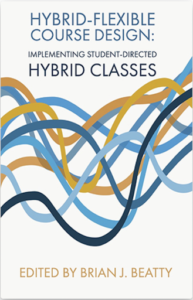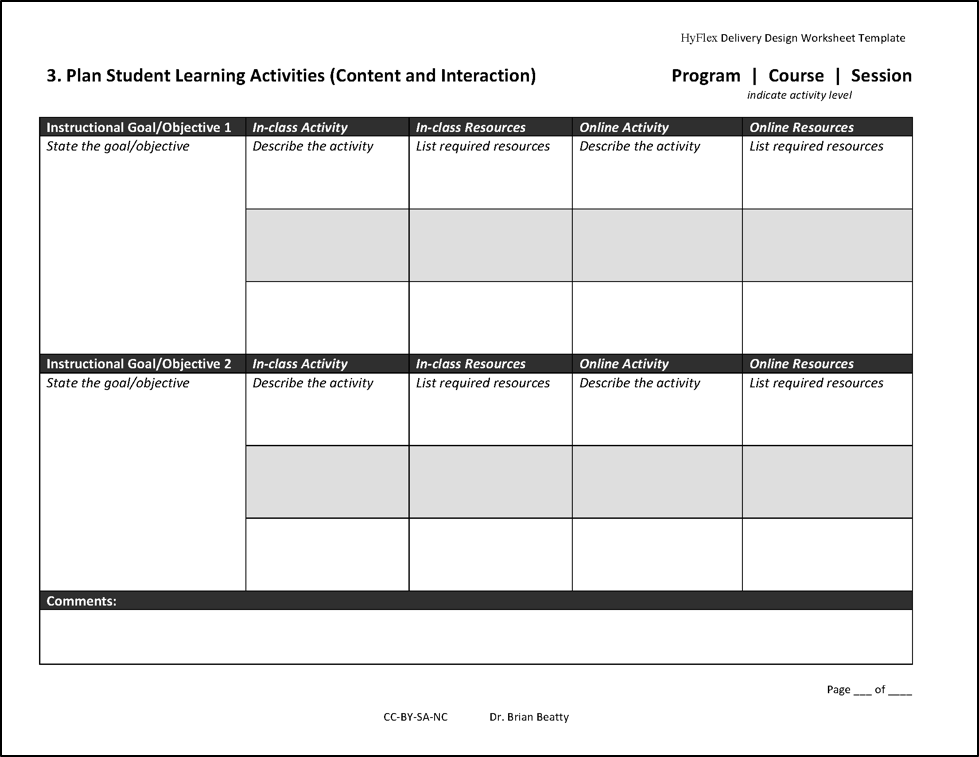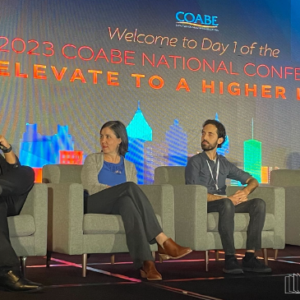The onset of the COVID-19 pandemic forced adult education programs across the country to rethink how they organize and deliver instruction. In response, most education providers adopted technology-based approaches faster and at a larger scale than ever before. As the pandemic has drawn on, programs have noticed that innovations put into place to maintain contact and provide instruction are worth sustaining.
One of these innovations is the hybrid-flexible model, or HyFlex, defined as instruction that is simultaneously hybrid, a combination of online and face-to-face, and flexible, students can choose to attend face-to-face or learn online (Beatty, 2019). This means that students can decide when and where to engage in instruction. One day, they might choose to attend in person in a classroom. Another day, they might choose to participate remotely via a web conferencing platform. Yet another day, they might need to do the work another time, perhaps asynchronously through online activities.
Why Hyflex?
In our work at the EdTech Center, we have heard from state directors, program leaders, and teachers about how moving classes to online formats (synchronous and asynchronous) has boosted flexibility and personalization. Removing the need to commute or attend class at only one set time has made it possible for learners to persist despite lack of transportation or conflicting work schedules and family obligations (Vanek, et al, 2021), and the digital medium of these classes has provided the means by which differentiated learning resources can be shared with learners – and tailored to each learner’s needs (Kallenbach et al, 2021).
These observations about the promise of technology-supported adult education programming have led many leaders to look for ways to continue to maximize flexibility and personalization in the months and years ahead; however, education leaders have also shared that they know there are learners who won’t enroll if they cannot attend in-person classes (Belzer, 2020). Given this tension, it’s clear that a multimodal approach to delivering instruction is needed. There are programs across the US that are experimenting with HyFlex as the way to do so.
HyFlex According to Beatty
Brian Beatty’s seminal writing on the HyFlex model provides clear description and implementation guidance for program administrators and teachers who want to learn about how to plan and implement HyFlex classes. The book, Hybrid-Flexible Course Design: Implementing Student-Directed Hybrid Classes is a useful how-to guide. Though Beatty’s focus has been at the post-secondary education level, the text offers support applicable in adult education settings.
In Beatty’s words, a HyFlex course is defined by these characteristics:
 Learner Choice: Provide meaningful alternative participation modes and enable students to choose between participation modes daily, weekly, or topically.
Learner Choice: Provide meaningful alternative participation modes and enable students to choose between participation modes daily, weekly, or topically.- Equivalency: Provide learning activities in all participation modes which lead to equivalent learning outcomes.
- Reusability: Utilize artifacts from learning activities in each participation mode as ‘learning objects’ for all students.
- Accessibility: Equip students with technology skills and equitable access to all participation modes. (Beatty, 2019)
Beatty writes that HyFlex courses can be designed and implemented through these steps:
- Assessing costs and benefits
- Analyzing current learning outcomes and adapting them to align with HyFlex model
- Planning, designing, and implementing instructional activities and content
- Designing formative and summative assessments
- Evaluating success of implementation (Beatty, 2019)
The book offers planning document templates that practitioners can use to move them through each of the steps. For example, this template provides structure for planning activities and content for HyFlex instruction.

Can HyFlex work in Adult Ed?
Beatty’s research shows that when done well, HyFlex classes offer learners multiple benefits. Learners can choose how, when, and where they will engage in learning. This supports persistence by maximizing flexibility. Learners also have access to instructional content presented in different modalities, which can support learning. For example, they can attend a class and then access a recording of a lesson or asynchronous learning activities to review.
However, HyFlex also presents challenges. Programs need to have teachers on staff who are willing to take on multimodal instruction. Then, these teachers need ample training, support, and time to develop instruction delivered in multiple formats. Programs also need to invest in the technologies and supports needed to deliver equitable instruction across all modalities.
We are in the early days of figuring out whether and how HyFlex will play out in adult education. This is work that we at the EdTech Center are deeply interested in. As part of my leadership of the IDEAL Consortium, I led a study group of Arizona educators working through Beatty’s book, in order to support the design and implementation of HyFlex classes for their programs. These educators are generously sharing their observations about their experiences. Look for these upcoming ways to hear from them:
In the second post in this blog series, HyFlex at Pima Community College, one of those teachers, Vi Hawes, describes her ESOL pilot. In a third post, we will share a ‘to do’ list for adult education practitioners who want to explore starting their own. Look for the next blog posts in the near future.
Additionally, David Howden from Arizona Center for Youth Resources and Jennifer Duclos from Mesa Adult Education share their work at our upcoming Distance Education Strategy Session webinar on December 10, 2021. Register for the webinar to hear firsthand what these educators have learned about HyFlex in the past six months.
You can also learn more about the HyFlex work of adult educators in the U.S. by signing up for The Flex Models Google group. Adult foundational skills educators, including adult basic skills education, ESOL/ESOL adult secondary education and post-secondary preparation, who are implementing or in the process of planning to implement, HyFlex or BlendFlex models. If you have questions about the Flex Models Google group, or would like to join, contact David Rosen at djrosen123@gmail.com.
Read other posts in this series.
Building on a Pilot: HyFlex ESOL Class at Pima Community College
References:
Beatty, B. J. (2019). Hybrid-Flexible Course Design (1st ed.). EdTech Books.
Belzer, A., Leon, T., Patterson, M., Rhodes, C., Salas-isnardi, F., Vanek, J., Webb, C, Willson-Toso, B. (2020). Covid-19 Rapid Response Report from the Field. ProLiteracy.
Vanek, A. J., Webber, A. A., Kallenbach, S., Singh, N., Uvin, J., González, C., & Crowe, A. (2021). Promising Practices for Adult Remote ESOL. World Education, Inc.
Kallenbach, A. S., Crowe, A., González, C., Singh, N., Uvin, J., Vanek, J., & Webber, A. A. (2021). Creating Equitable Access to Remote Adult ESOL: Multiple Contexts, Distinct Populations, and Diverse Purposes. World Education.




